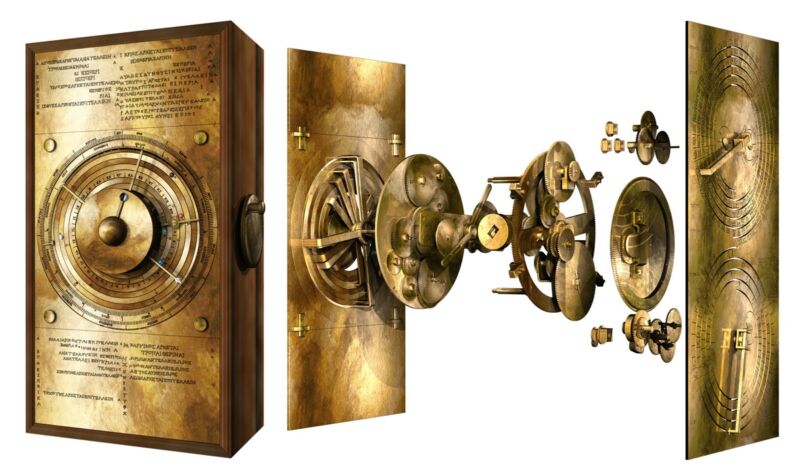An ancient cosmic computer —
“Our reconstruction fits all the evidence… gleaned from the extant remains to date.”
Jennifer Ouellette
–

Enlarge / “Exploded” view of the new computer model of the Antikythera mechanism, showing how it might have worked.
Tony Freeth
Scientists have long struggled to solve the puzzle of the gearing system on the front of the so-called Antikythera mechanism—a fragmentary ancient Greek astronomical calculator, perhaps the earliest example of a geared device. Now, an interdisciplinary team at University College London (UCL) has come up with a computational model that reveals a dazzling display of the ancient Greek cosmos, according to a new paper published in the journal Scientific Reports. The team is currently building a replica mechanism, moving gears and all, using modern machinery. You can watch an extensive 11-minute video about the project here (embedding currently disabled).
“Ours is the first model that conforms to all the physical evidence and matches the descriptions in the scientific inscriptions engraved on the mechanism itself,” said lead author Tony Freeth, a mechanical engineer at UCL. “The Sun, Moon, and planets are displayed in an impressive tour de force of ancient Greek brilliance.”
“We believe that our reconstruction fits all the evidence that scientists have gleaned from the extant remains to date,” co-author Adam Wojcik, a materials scientist at UCL, told the Guardian.
The hand-powered Antikythera mechanism has a long history. In 1900, a Greek sponge diver named Elias Stadiatis discovered the wreck of an ancient cargo ship off the coast of Antikythera island in Greece. He and other divers recovered all kinds of artifacts from the ship. A year later, an archaeologist named Valerios Stais was studying what he thought was just a piece of rock recovered from the shipwreck, but he noticed there was a gear wheel embedded in it. It turned out to be an ancient mechanical device. The Antikythera mechanism is now housed in the National Archaeological Museum of Athens.
The 82 surviving fragments of the device were originally housed in a wooden box roughly the size of a shoebox, with dials on the outside, containing a complex assembly of gear wheels within. The largest piece is known as Fragment A, which has bearings, pillars, and a block. Another piece, Fragment D, has a disk, a 63-tooth gear, and plate. The mechanism’s very existence offers strong evidence that such technology existed as early as 150-100 BC, but the knowledge was subsequently lost. Similar machines with equivalent complexity didn’t appear again until the 18th century. While it was found on a Roman cargo ship, historians believe it is Greek in origin, possibly from the island of Rhodes, which was known for impressive displays of mechanical engineering.
It took decades just to clean the device off, and in 1951, a British science historian named Derek J. de Solla Price began investigating the theoretical workings of the device. Based on X-ray and gamma ray photographs of the fragments, Price and physicist Charalampos Karakalos published a 70-page paper in 1959 in the Transactions of the American Philosophical Society. Based on those images, Price hypothesized that the mechanism had been used to calculate the motions of stars and planets—making it the first known analog computer.
In 2002, Michael Wright, then curator of mechanical engineering at the Science Museum in London, made headlines with new, more detailed X-ray images of the device taken via linear tomography—which means that only features in a particular plane come into focus, enabling closer inspection and pinning the exact location of each gear. Wright’s closer analysis revealed a fixed central gear in the mechanism’s main wheel, around which other moving gears could rotate. He concluded that the device was specifically designed to model “epicyclic” motion, in keeping with the ancient Greek notion that celestial bodies moved in circular patterns called epicycles. (This was pre-Copernicus, so the fixed point around which they moved was believed to be the Earth.)

